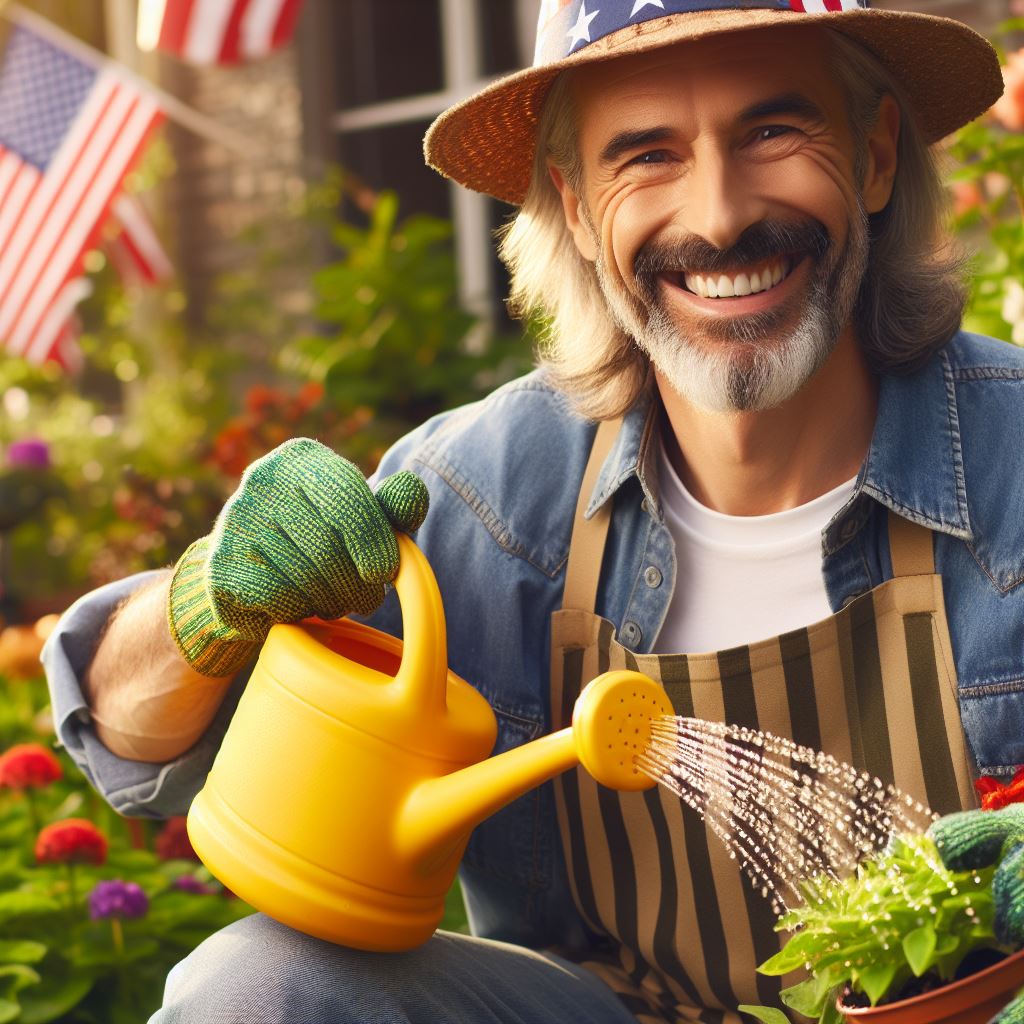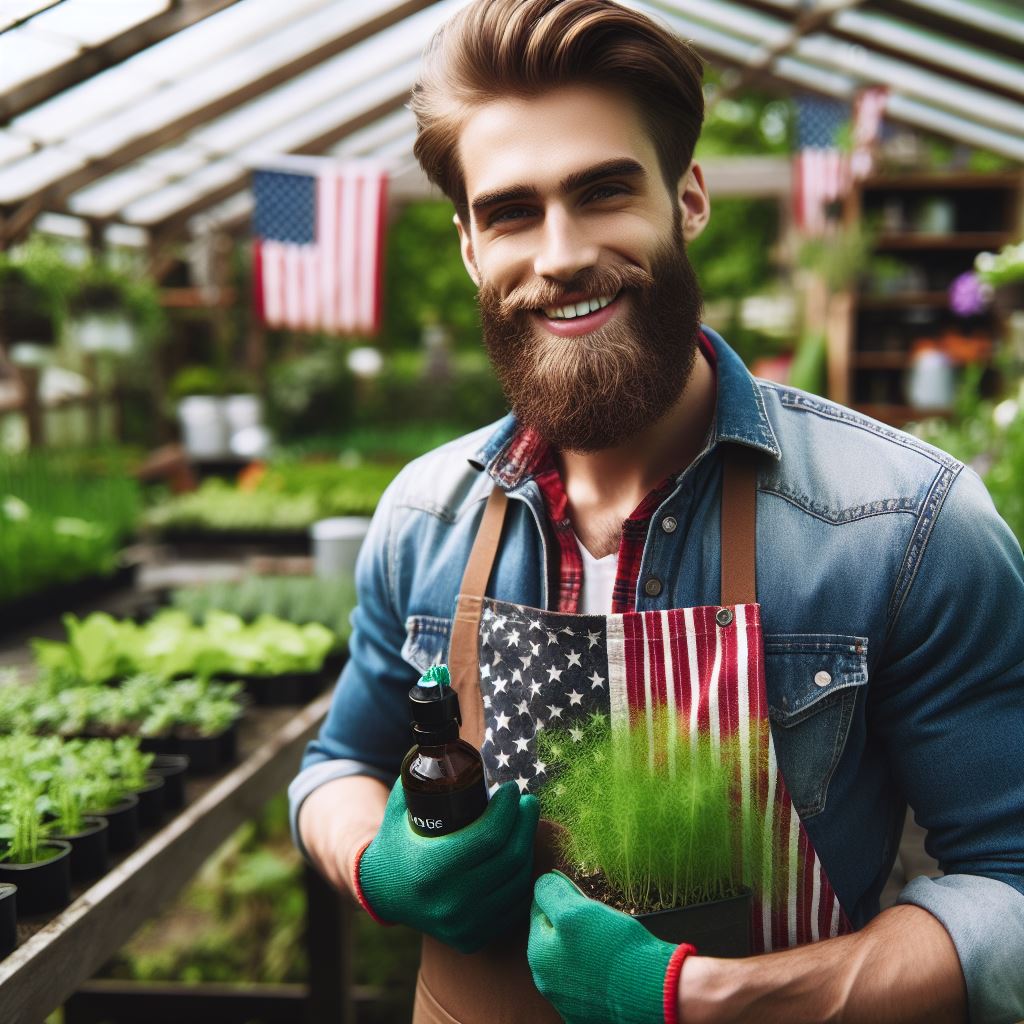Introduction
Brief explanation of water-wise gardening
Water Wise Gardening Steps for Hobbyists entail adopting sustainable gardening techniques to minimize water usage.
This approach emphasizes a mindful and eco-friendly approach to gardening, ensuring that hobbyists play a crucial role in water conservation.
It is a practice that hobbyists should embrace, not only to reduce costs but also to conserve the environment.
By adopting water-wise gardening, hobbyists can enjoy various advantages that greatly impact their gardens and wallets.
Overview of the benefits of water-wise gardening
Firstly, implementing water-wise gardening methods can significantly lower water bills.
By being mindful of water consumption, hobbyists can conserve water and reduce their expenses.
Water-wise gardening techniques, such as using mulch, proper irrigation, and drought-tolerant plants, can ensure efficient water usage, leading to substantial cost savings over time.
Moreover, water-wise gardening increases plant survival rates.
By providing plants with proper watering techniques and utilizing strategies like using moisture-retaining soil additives, gardeners can create ideal conditions for plants to thrive.
The careful and efficient use of water prevents over-watering or under-watering, which can lead to healthier and more resilient plants.
Lastly, water-wise gardening requires less maintenance.
By focusing on drought-tolerant plants that can withstand dry conditions, hobbyists can spend less time watering and maintaining their gardens.
Additionally, using techniques like drip irrigation or rainwater harvesting systems can automate the watering process, reducing the need for constant attention and effort.
Basically, water-wise gardening is a sustainable approach that offers numerous benefits for hobbyists.
It saves money, promotes plant survival, and reduces maintenance time and effort.
Transform Your Agribusiness
Unlock your farm's potential with expert advice tailored to your needs. Get actionable steps that drive real results.
Get StartedBy embracing water-wise gardening techniques, hobbyists can create beautiful and thriving gardens while contributing to water conservation efforts.
Assessing Water Needs
Determining climate and regional water availability
- Research the typical weather patterns and rainfall amounts in your area.
- Consider the availability and quality of local water sources, such as rivers or wells.
- Take note of any water restrictions or regulations in your region.
Understanding different plant water requirements
- Learn about the water needs of the specific plants in your garden.
- Consider factors such as plant type, size, and stage of growth.
- Some plants require more water, while others are more drought-tolerant.
Conducting a soil moisture test
- Use a soil moisture meter or simply dig a small hole and feel the soil with your fingers.
- Determine if the soil is moist, dry, or saturated with water.
- Keep in mind that different plants have different soil moisture preferences.
Choosing the right watering methods for the garden
- Consider factors such as water efficiency, plant type, and garden size.
- Options include hand watering, sprinklers, drip irrigation, and soaker hoses.
- Research the pros and cons of each method to make an informed decision.
Determining climate and regional water availability
By properly assessing water needs, you can ensure that your garden receives the right amount of water without wasting this precious resource.
Understanding climate and regional water availability is key to planning your watering schedule and avoiding any conflicts with local water regulations.
Knowing the specific water requirements of your plants will allow you to adjust your watering practices accordingly.
Conducting a soil moisture test
Conducting a soil moisture test is an essential step in determining when and how much to water your plants.
This will help you avoid both overwatering and underwatering, which can both be detrimental to plant health.
By choosing the right watering methods for your garden, you can maximize water efficiency and minimize water loss through evaporation.
This will save you time, money, and conserve water resources.
Remember to regularly monitor your garden’s water needs and make adjustments as necessary.
Factors such as rainfall, temperature, and plant growth can all affect how much water your garden requires.
Stay observant and responsive to ensure that your plants thrive while being water-wise.
Read: Maximize Yields, Minimize Water in Urban Farms
Choosing Water-Wise Plants
Opting for native or drought-tolerant plant varieties
One of the key factors in creating a water-wise garden is selecting plants that are adapted to your local climate and soil conditions.
Native plants are an excellent choice as they are already well-suited to the area’s natural rainfall patterns.
They have evolved to withstand local weather conditions, making them more resilient and able to thrive with less water.
Additionally, drought-tolerant plant varieties, which are often native to arid regions, are specifically bred to withstand extended periods of drought without sacrificing their beauty.
Researching plants with low water requirements
To further conserve water in your garden, it is important to research and select plant varieties with low water requirements.
These plants typically have the ability to survive with minimal irrigation or rainfall once established.
Look for species that have adapted to arid conditions over time and prioritize those that need less frequent watering.
By choosing plants with low water requirements, you can significantly reduce your garden’s water consumption and conserve this precious resource.
Selecting plants with deep root systems
Plants with deep root systems are more efficient at accessing water from the soil, making them an excellent choice for water-wise gardening.
These roots can reach deeper into the ground, tapping into water sources that other plants cannot access.
Deep-rooted plants are also better able to withstand drought conditions as they can draw water from deeper soil layers when surface moisture is limited.
When selecting plants, consider those with longer taproots or well-developed root networks to maximize their water uptake abilities.
Showcase Your Farming Business
Publish your professional farming services profile on our blog for a one-time fee of $200 and reach a dedicated audience of farmers and agribusiness owners.
Publish Your ProfileConsidering xeriscaping techniques for landscaping
Xeriscaping is a landscaping technique that focuses on conserving water and creating a sustainable, low-maintenance garden.
By incorporating xeriscaping principles into your garden design, you can create a visually appealing landscape while minimizing water use.
This technique involves using drought-tolerant plants, mulching to retain soil moisture, grouping plants based on water needs, and minimizing areas of turf.
Xeriscaping not only saves water but also reduces the need for excessive irrigation, fertilizers, and pesticides, making it an eco-friendly choice for any gardener.
In general, selecting water-wise plants is essential for creating a sustainable and environmentally friendly garden.
By opting for native or drought-tolerant plant varieties, researching plants with low water requirements, choosing plants with deep root systems, and considering xeriscaping techniques, hobbyists can create a beautiful garden while conserving water.
These simple steps not only promote water conservation but also reduce the maintenance and resources required to keep your garden thriving.
Embrace water-wise gardening and make a positive impact on the environment while enjoying the beauty of your landscape.
Read: Eco-Friendly Farming: Water Conservation Tricks
Soil Preparation and Mulching
Importance of well-drained soil for water-wise gardening
When preparing your garden for water-wise gardening, paying attention to soil preparation and mulching is crucial.
Well-drained soil plays a vital role in this type of gardening.
It allows excess water to flow away, preventing waterlogging and root rot.
Additionally, it promotes proper aeration and nutrient uptake by plant roots.
Improving soil structure and water retention
To ensure well-drained soil, it is essential to improve soil structure and water retention.
If your soil is compacted, it is necessary to loosen it.
This will not only enable better water infiltration but also enhance root penetration.
One effective method to achieve this is by incorporating organic matter, such as compost, into the soil.
Organic matter not only improves soil structure but also increases its water-holding capacity.
Incorporating organic matter into the soil
Incorporating organic matter into the soil can be done using various materials such as compost, aged manure, and leaf litter.
Compost, for instance, is an excellent source of nutrients and organic matter that improves soil health.
It enriches the soil and helps plants grow better, while also improving its water retention capacity.
Similarly, aged manure and leaf litter provide essential nutrients and contribute to overall soil fertility.
Applying mulch to conserve soil moisture and reduce evaporation
Apart from soil preparation, applying mulch plays a vital role in water-wise gardening.
Mulching involves placing a layer of organic material on the soil surface, acting as a protective barrier.
This layer helps conserve soil moisture by reducing evaporation.
Additionally, it assists in regulating soil temperature, keeping it cooler during hot weather, resulting in reduced water loss through evaporation.
Mulch can be made from various materials, such as straw, wood chips, or shredded leaves.
When applying mulch, ensure a thickness of around 2-4 inches to effectively conserve soil moisture.
However, it’s crucial to avoid piling mulch directly against the plant stems, as this can lead to rot or disease.
Leave a small space around the stem to prevent any damage.
Furthermore, as the mulch breaks down over time, it adds organic matter to the soil, improving its overall health and fertility.
It also helps suppress weed growth, which can compete for water with your plants.
In essence, soil preparation and mulching are essential steps in water-wise gardening.
By ensuring well-drained soil, improving soil structure, incorporating organic matter, and applying mulch, you can conserve soil moisture, reduce evaporation, and create an optimal environment for your plants.
These practices not only benefit your garden but also contribute to water conservation efforts.
Read: Small Garden? Big Savings: Water Efficiency Tips
Efficient Watering Techniques
Efficient watering techniques are essential for maintaining a healthy garden while conserving water resources.
By understanding the various methods available and implementing proper watering practices, hobbyist gardeners can make a significant impact on water conservation.
Irrigation methods: drip or soaker hoses, micro-sprinklers
One of the most effective ways to minimize water usage in gardening is by using efficient irrigation methods.
Instead of employing traditional sprinklers that tend to waste water through evaporation, consider utilizing drip or soaker hoses, or micro-sprinklers.
Showcase Your Farming Business
Publish your professional farming services profile on our blog for a one-time fee of $200 and reach a dedicated audience of farmers and agribusiness owners.
Publish Your ProfileThese options deliver water directly to the root zones of plants, reducing water loss and ensuring efficient absorption.
Drip or soaker hoses are ideal for gardens with rows of plants or individual plantings.
These hoses release water slowly, close to the soil surface, minimizing evaporation and targeting plant roots.
Likewise, micro-sprinklers provide a gentle mist that effectively waters plants without unnecessary runoff or wastage.
Installing rain barrels or water-collection systems
Another excellent water-saving technique for hobbyist gardeners is the installation of rain barrels or water-collection systems.
These devices collect and store rainwater that can be used for watering your garden.
By capturing rainwater, you reduce the need for municipal water sources, contributing to water conservation efforts.
Installing rain barrels is relatively simple.
Choose a location near a downspout or gutter to collect rainwater from your roof.
Use a filter to prevent debris from entering the barrel, and attach a hose or spigot for easy access to the collected water.
By incorporating this system into your garden, you can significantly reduce your reliance on potable water for irrigation purposes.
Using irrigation timers and moisture sensors
To ensure efficient watering, consider utilizing irrigation timers and moisture sensors.
These tools assist in maintaining appropriate moisture levels in your soil while preventing overwatering or underwatering.
Irrigation timers can be programmed to water at specific times, ensuring consistent and adequate hydration for your plants.
They also help avoid forgetting to water or overwatering, thus reducing water waste.
Additionally, moisture sensors can be placed in the soil to measure its moisture content accurately.
These sensors provide real-time feedback, allowing you to adjust irrigation schedules accordingly.
Watering at appropriate times to reduce evaporation
Timing is crucial when it comes to watering your garden efficiently.
To minimize water loss due to evaporation, it is best to water your plants in the early morning or late afternoon.
During these times, temperatures are cooler, and the sun’s intensity is lower, allowing the water to penetrate the soil effectively.
Avoid watering during peak heat hours when evaporation rates are higher.
By adjusting your watering schedule accordingly, you can ensure that water is utilized optimally, promoting healthier plants and reducing water wastage.
Efficient watering techniques are vital for water-wise gardening enthusiasts.
By employing drip or soaker hoses, installing rain barrels, utilizing irrigation timers and moisture sensors, and watering at appropriate times, hobbyist gardeners can contribute to water conservation efforts while maintaining a thriving garden.
Read: Urban Farm Water-Saving: Top 5 Effective Methods

See Related Content: Indoor Herb Magic: Grow Basil, Mint & More
Water-Saving Tips
Achieving a water-wise garden doesn’t have to be complicated.
By implementing these simple steps, hobbyists can conserve water and still maintain a beautiful garden.
Using water-efficient tools, such as trigger nozzles
Investing in water-efficient tools can significantly reduce water waste in the garden.
Trigger nozzles are a great option as they allow gardeners to control the water flow easily.
- Trigger nozzles ensure that water is only released when necessary, avoiding unnecessary wastage.
- By using trigger nozzles, hobbyists can target specific plants and areas that require watering, conserving water.
Capturing and reusing household water for the garden
Instead of letting household water go to waste, it can be captured and reused in the garden, promoting a sustainable water-saving practice.
- Place buckets or containers under downspouts to collect rainwater, which can then be used for watering plants.
- Greywater from activities like dishwashing or laundry can also be collected and reused in the garden. Ensure to use eco-friendly detergents and chemicals.
Removing weeds and grass near plants to reduce competition
Weeds and grass compete with plants for water, so removing them can help reduce water consumption and ensure the health of desired plants.
- Regularly weed your garden beds to eliminate competition for water resources.
- Consider using mulch to suppress weed growth, conserve moisture, and reduce the need for excess watering.
Monitoring weather conditions to adjust watering schedules
Adapting watering schedules based on weather conditions ensures your garden receives the right amount of water, preventing overwatering or dehydration.
- Check local weather forecasts and adjust watering frequency accordingly, avoiding unnecessary watering during rainy periods.
- During hot and dry spells, increase watering but ensure it penetrates deep into the soil to encourage proper root growth.
In a nutshell, water-wise gardening involves using water-efficient tools, capturing household water, removing weeds, and monitoring weather conditions.
By implementing these tips, hobbyists can create a thriving garden while conserving precious water resources.
Let’s do our part in being responsible gardeners and contribute towards a more sustainable future.
See Related Content: Mushroom Cultivation for Small Gardens
Managing Water Runoff
Designing the garden to prevent water runoff
- Create landscaping barriers such as berms or retaining walls to redirect water flow.
- Install a rain gutter system that guides water away from the garden.
- Plant trees strategically to help absorb excess water runoff.
- Opt for native plants that are well-adapted to local rainfall patterns.
Creating gentle slopes and channels for drainage
- Grade your garden to ensure proper drainage by sloping the surface away from buildings.
- Create shallow channels or swales to guide water towards desired areas.
- Avoid steep slopes that could cause erosion and rapid water runoff.
- Consider using terraces or steps to slow down water movement down slopes.
Implementing permeable surfaces to reduce runoff
- Use gravel or crushed stone paths instead of concrete to allow water to seep into the ground.
- Consider using permeable pavers or bricks for walkways and patios.
- Add organic mulch to the garden beds, which can help absorb water and reduce surface runoff.
- Avoid using asphalt or solid pavements that prevent water from infiltrating the soil.
Utilizing rain gardens and swales to capture and filter runoff
- Create a rain garden in areas prone to water runoff to capture and retain rainwater.
- Select plants that are tolerant of both periods of saturation and drought.
- Add a layer of organic matter in rain gardens to improve water filtration and retention.
- Consider constructing swales, shallow ditches, to direct water and filter pollutants.
By designing the garden thoughtfully, considering the slope, surface material, and incorporating water-capturing features, hobbyists can effectively manage water runoff in their gardens.
This ensures water is conserved and prevents soil erosion, pollution, and local flooding.
Implementing these methods not only benefits the garden but also contributes to a sustainable water-wise approach.
Showcase Your Farming Business
Publish your professional farming services profile on our blog for a one-time fee of $200 and reach a dedicated audience of farmers and agribusiness owners.
Publish Your ProfileConclusion
Recap of the key points discussed in the blog post
- Water-wise gardening can help conserve water and reduce water bills.
- Choosing the right plants, improving soil quality, and mulching are essential techniques.
- Proper watering techniques, such as deep watering and using drip irrigation, save water.
- Regular maintenance and ongoing observation are crucial for a successful water-wise garden.
By implementing these simple steps, anyone can contribute to water conservation efforts and create a beautiful, sustainable garden.
Further resources on sustainable gardening techniques
For more in-depth knowledge and inspiration, explore the following resources:
- Websites: XYZ Gardening, Waterwise Gardening Association
- Books: “Water-Smart Gardening” by XYZ Author, “Sustainable Landscaping for Dummies” by XYZ Author
- Local gardening classes, workshops, and community garden programs
Remember, embracing water-wise gardening practices not only benefits the environment but also enhances your gardening experience.
Together, let’s make every drop count!




